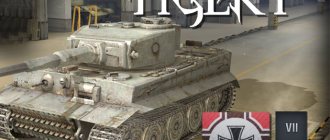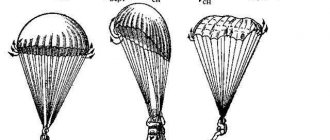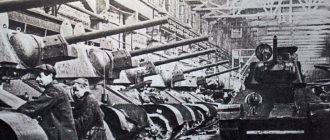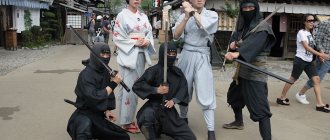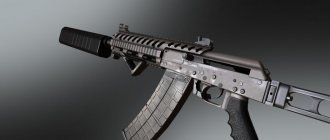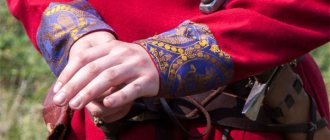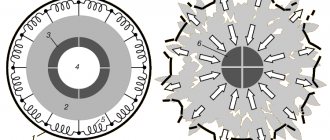Historical facts
Russian chroniclers often embellished the abilities of past rulers. And the more famous the prince was, the more legends were formed. Therefore, it is not surprising that chroniclers called Alexander Nevsky’s weapon heroic, extolling other two-handed swords that his opponents used.
They first started talking about this during the time of Ivan the Terrible (3 centuries later). Then reports appeared in the chronicles that a bright light emanated from the sword of the Russian prince, which frightened the Swedes and helped them win the battle. And in the illustrations of that time the weapon was depicted with a long and massive blade.
In the chronicles there is a mention that the Russian prince could cut off the heads of three opponents with a sword in one blow. But, as historians believe, Swedish soldiers gave such a halo to the weapon to justify defeat in the battle. According to established facts, during the battle on Lake Ladoga, Nevsky broke his sword on the head of the Swedish leader. That is, the prince’s weapon was not the same as the legends describe.
At the same time, it has not yet been possible to accurately refute these mystical writings, since the sword of Alexander Nevsky has not yet been found. Historians have collected scattered information about Russian weapons:
- After the battle, the sword was placed in the house of Elder Philip (Pelgus), which later burned down.
- In the 17th century, monks, while plowing land in the Pskov province, where Philip’s house was previously located, dug up weapons. This happened next to the temple, erected by decree of Peter 1 in honor of the Battle of the Neva. The legendary blade was placed under the foundation.
- After the formation of the USSR, Soviet commanders ordered the burning of manuscripts in a Pskov church. But later manuscripts of a White Guard were found who described this blade in detail.
The mystical connotation of Nevsky’s blade was also given by the fact that the temple in which the weapon was supposedly placed was preserved intact before the formation of the USSR, despite natural disasters.
The weight of a two-handed sword, let's find out the truth
How much does a two-handed sword weigh? The most interesting thing is that incorrect data can also be heard from historians. According to some statements, the two-handed sword was a tool of power, heavy and heavy. Made only to cut the enemy in half from top to bottom. The above question can be answered by fencing practitioners who value the weight and size of the product.
The appearance of the term - two-handed sword
The appearance of the large bastard sword dates back to the Middle Ages. It was common in Europe between the 14th and 17th centuries. Such a product was held with two hands in battle. But if necessary, it could be operated with one hand. But this required considerable strength. The blades quickly gained popularity.
If we turn to medieval sources, it becomes clear that the names for weapons were simple - sword or bastard bastard sword. A little later in the 19th century, when creating the classification, collectors gave the sword the name two-handed. The term is firmly entrenched to this day.
Two-handed sword design
The structure of a bladed weapon determines its effectiveness. Accordingly, weight and size determine its technique of use. When manufacturing such weapons, the following parameters are taken into account:
- blade cross-section, which determines the type of blows delivered;
- blade profile, which is inherent in all swords;
- distribution of blade mass, according to the type of narrowing;
- balancing, location of the center of gravity.
A two-handed sword consists of a blade and a hilt, nothing ordinary. The structure of the hilt is classic: pommel, guard and handle. Sheaths were not made for them, but sometimes there are some kind of sheaths that are not attached to anything.
A special feature of the blade is the presence of a ricasso.
This area behind the crosspiece was not sharpened; it was needed for hand gripping. It was often wrapped in leather. Along the blade towards the tip, after the ricasso, there was a small counterguard.
Truth and speculation about the weight of the sword
Quite often, historians or archivists who are not familiar with fencing argue that the two-handed sword was heavy and clumsy. Even modern athletes sometimes make similar statements. But we should not forget that in the Middle Ages a warrior was dressed in armor, and to break through it a massive blade was required.
Sword fight
Again, returning to movies in which directors show us thick and heavy swords, the fight with which is similar to a fight with clubs.
Heavy blow
Fencing on such specimens looks like an alternating combination of sweeping, heavy and powerful blows from opponents.
But using common sense, it becomes clear that swinging a 20-kilogram weapon, even for trained warriors, would be oh so hard. Often, what the cinematograph shows us are “wall-mounted” products.
Let us not forget that in those days good steel was quite valuable. Not everyone could afford to make such a large sword.
Indeed, there were products weighing up to 25 kg. Externally very similar to combat ones. But their purpose was to hang on the wall, to assert the high status of the owner. This is how wealth and wealth were shown in those days.
In reality, two-handed combat swords were not intended for chopping, but for precise strikes on vulnerable spots in armor and armor. The weight of the products did not exceed 4 kilograms. On average they weighed 2.5-3 kg. There were also tournament swords; they were more bulky, but the purpose of their use was completely different.
Weapons in battle
The most important disadvantage of a two-handed sword is its length and inertia. At the moment the blow is completed, the warrior remains practically unprotected. And if the enemy managed to parry the blow with his shield, the two-handed sword becomes useless for a couple of seconds:
- it is necessary to pick it up and bring it to a new blow. This short period of time is enough for the enemy to approach and inflict a mortal wound;
- the same situation arises if there are several enemies. Having successfully slashed one enemy, it takes time to remove the blade from the body. Once again the warrior becomes an easy prey for others.
It is for this reason that when fencing with a two-handed sword, they try to reach the enemy with the very tip so that he does not get stuck. In combat, the long handle is held with both hands in front of the body. The right hand pushes the sword forward, and the left hand pulls the hilt back. This tactic allows you to save strength and allows the fighter to be maneuverable.
How much did the average sword weigh?
Historians have counted several dozen types of weapons that were used in Rus' in ancient times. Adding to the difficulty in classifying swords of that time is the fact that less than 100 similar objects have been found to date. But it is known that Russian warriors from the 13th century used blades weighing 1.5 kilograms. Products decorated with precious stones and gold were also found. Because of this, the weight reached five kilograms.
Old Russian swords. Procurement and import substitution
As you know, coming to Rus' with a sword is fraught with death from such a weapon. Indeed, the Russian army had a large number of swords and with their help repeatedly met enemies. The first swords appeared no later than the 9th century, and quite quickly such samples became widespread, becoming one of the main weapons of infantry and cavalry. Swords served for several centuries, after which they gave way to newer and more advanced bladed weapons.
Swords of the 9th-11th centuries, found in the Gnezdovo burial mounds. Photo Mihalchuk-1974.livejournal.com
History of the sword
Traditionally, the history of swords in Rus' is divided into two main periods.
The second begins in the 9th century. and covers the first half of the 10th century. It is from this period that the oldest archaeological finds in the lands of the Eastern Slavs date back. It is believed that by the 9th-10th centuries. swords managed to become widespread in other parts of Europe, and soon came to our lands, where they were appreciated. The first swords in Rus' belonged to the so-called. Carolingian type. Such weapons were found in various graves in different regions, mainly near the centers of political and economic life. To date, more than a hundred swords of the first period have been discovered and studied.
Finds of swords up to and including the sixties. Map from the book by A.N. Kirpichnikov “Ancient Russian weapons”, vol. 1, “Swords and sabers of the 9th-13th centuries.”
In the X-XI centuries. There was a gradual displacement of the Carolingian sword. It was replaced by a sword of the Romanesque or Capetian type. Similar weapons are found in burials and cultural layers from the 10th to the 13th centuries. It is curious that the swords of the second period, despite its greater duration, were preserved in smaller quantities - no more than 75-80 units. The small number of finds is explained by the disappearance of the tradition of burying weapons with the owner.
Apparently, it was after the 10th century. All known traditions associated with swords were finally formed. The sword was considered an important attribute of power and troops. Various phraseological units associated with blades also appeared. The sword has become synonymous with forceful methods.
Procurement and import substitution
The origin of the swords of the ancient Russian army is extremely interesting. The first examples of such weapons were brought from foreign lands. Then the purchase of imported products continued and remained relevant for several centuries. Foreign gunsmiths, having a certain head start in time, managed to develop the necessary technologies and produced high-quality weapons.
Types of sword hilts dating back to the 9th-10th centuries. Table from the book by A.N. Kirpichnikov “Ancient Russian weapons”, vol. 1, “Swords and sabers of the 9th-13th centuries.”
The main supplier of swords for Ancient Rus' was the Carolingian Empire. Weapons were also purchased from Varangian craftsmen. Some swords came in completely finished form, while others were bought in the form of just one blade or a blank for it. The blade was supplemented with a locally made handle.
Swords and blades of foreign origin can be identified by the corresponding marks. Thanks to this, the origin of several dozen finds from different regions was clearly established. For example, swords with the “ULFBERHT” mark are quite widespread both here and in Europe.
Over time, ancient Russian blacksmiths mastered the production of their own swords, but the results of this are still a topic of debate. The production and sale of swords in Rus' is repeatedly mentioned in the works of foreign travelers and chroniclers, but such data does not quite fit with real archaeological finds.
Later swords of the 11th-13th centuries. table from the book by A.N. Kirpichnikov “Ancient Russian weapons”, vol. 1, “Swords and sabers of the 9th-13th centuries.”
At the moment, only a few swords are known that were definitely made in Rus'. The first is a sword from the Foshchevataya borough (Poltava province), dated to the first half of the 11th century. On both sides of his blade there are the inscriptions “KOVAL” and “LYUDOTA” (or “LYUDOSHA”). In design and execution, this sword is reminiscent of Scandinavian ones. The second discovery was made at the end of the 19th century. in the Kyiv province. It was a 28 cm fragment of a sword with significant damage. The surviving part had the engraving “SLAV”.
Cyrillic inscriptions on these artifacts suggest their Old Russian origin. Thus, the very fact of sword production in Rus' is confirmed. At the same time, the production volumes, the share of the army’s armaments, etc. remain unclear. Perhaps answers to all such questions will appear later, based on the results of new discoveries and research.
Development ways
Archaeological finds show that generally the same basic types of swords were used in Rus' as in other regions of Europe. First of all, this was facilitated by active purchases of imported weapons. As for locally produced swords, their creators worked with an eye on foreign experience - which led to the observed consequences.
A sword with the ULFBERHT mark found in Gnezdovo (above). Photo: Wikimedia Commons
Swords of the first period, 9th-10th centuries, usually have a length of less than 1 m and weigh no more than 1-1.5 kg. Blades made using different technologies have been preserved. Swords with steel blades welded onto an iron base were widespread. Solid iron swords are also known. Handles of different types were used, incl. different design.
In addition to various marks on the finds, there are signs of artistic decoration. Also, similar features of weapons are mentioned in historical sources. Rich and noble swordsmen could afford to decorate their weapons with copper, silver or gold inlay, etc. In particular, a broken sword with the inscription “SLAV” had a similar design.
After the X-XI centuries. there is a design change. Improvements in technology have made it possible to lighten swords and increase their weight to 1 kg with a length of up to 85-90 cm. Longer and heavier swords are appearing, up to 120 cm and 2 kg, as well as lightweight products for cavalry. A characteristic feature of later swords is a gradual decrease in the width of the fuller, associated with improved manufacturing technologies.
A modern replica of the sword “LYUDOSHA KOVAL”. Photo Mihalchuk-1974.livejournal.com
Along with the design of the sword, the methods of its use changed. During the first centuries, the ancient Russian sword, like its foreign counterparts, was primarily a cutting weapon. In the XI-XII centuries. The idea of stabbing strikes arises and is introduced, which leads to a change in the design of the handle and crosspiece. In the 13th century. sharpened swords appeared, equally suitable for cutting and thrusting. Thus, the functions of swords gradually changed, but their original capabilities remained basic and did not give way to new ones.
End of an era
According to archaeological data, already in the 10th century.
Old Russian warriors became acquainted with a curved blade - a saber. Over the next few centuries, the straight and curved blades were used in parallel, each in its own niche. The saber was of greatest interest to the cavalry, where it gradually replaced existing types of swords. However, not all riders switched to such weapons. The infantry also retained swords. Significant changes in weapons began after the 13th century. Changes in tactics and fighting techniques led to an increase in the role of the saber and a reduction in the spread of swords. Such processes took quite a long time, but led to known results. By the XV-XVI centuries. swords finally gave way to more progressive weapons that met current requirements. Their era is over.
General trends
Swords came to Rus' from other countries and quickly took their place in the equipment of warriors. Such weapons met the requirements of their time and allowed foot or mounted soldiers to effectively solve existing problems. Swords turned out to be successful and convenient weapons, which allowed them to remain relevant for several centuries.
Reconstruction of the inscription on the sword “SLAV”. Drawing by A.N. Kirpichnikova / rus-druzhina.ru
As follows from the known data, most of the swords in Rus' were of foreign origin. Accordingly, the development of such weapons followed the main European trends. There was also domestic production, but the lack of data about it does not allow us to draw serious conclusions. Apparently, local swordsmiths also tried to follow foreign trends, and their swords turned out to be similar to imports.
Following foreign trends taking into account local requirements has led to well-known results. The swords purchased and forged generally corresponded to current requirements and evolved in accordance with various factors. Thanks to this, swords remained one of the main weapons of warriors for several centuries, but then they had to give way to weapons of new classes.
How much does Alexander Nevsky's sword weigh?
According to legends, the weight of this weapon reached five pounds. This means that the prince had the strength of a Russian hero. 1 pood is equal to 16 kilograms. That is, if you believe the legends, the weight of the blade reached 82 kilograms.
This figure is exaggerated by chroniclers in order to show that Nevsky had great power. The prince probably used the same weapons as other Russian warriors of the 13th century. At that time, as the results of excavations show, swords weighing 1.5 kilograms were in use. There were also lighter specimens. But Nevsky, who was the main commander, had to have strong and large weapons. Therefore, the weight of the blade most likely reached 1.5 kilograms.
Alexander Nevsky could not have held a heavier weapon in his hands. Historians have calculated that at the time of the battle the prince weighed 70 kilograms with a height of 1.68 meters.
Sword of Prince Svyatoslav Igorevich
We have already mentioned the sword of Prince Svyatoslav in the article “History of the Sword: Carolingian Strike”. In short, this is a Carolina type sword, very well preserved and richly crafted. It was found completely by accident - on November 7, 2011, Kiev resident Sergei Pyankov cast a fishing rod and pulled a 96-centimeter sword out of the water.
There are actually no reasons to attribute this sword to Svyatoslav. Yes, this is a very ornate sword. Yes, he is a contemporary of Svyatoslav. Yes, he was found in the very place where Svyatoslav gave his last battle. All this - yes, it is so.
However, nothing confirms that it was Svyatoslav who fought with this sword. Not a single stroke confirms it!
Mystical sword
Russian troops won, despite their minority. Nevsky was an outstanding tactician, therefore, thanks to his intelligence and fearlessness, the soldiers defeated the enemy. There is also a mystical episode in this story. According to legend, the enemy was scared to death by Alexander Nevsky’s saber, which glowed very strangely. Alexander mastered this weapon perfectly, hitting three Swedes at once with one shot. But, as they say, fear has big eyes. The mystical aura was most likely given to the weapon by the Swedish soldiers to justify their defeat. And Alexander Nevsky’s sword simply fell under the rays of the sun.
The fact is that Russian troops collided with a celestial body. His beam hit the raised sword, and the frightened Swedish army mistook it for something supernatural. Also in this battle, the prince broke a weapon on the head of Birger, the leader of the enemies. After the victory in this battle, Prince Alexander received his sonorous nickname - Nevsky.
Sword of Prince Dovmont of Pskov
Not everything is simple with Prince Dovmont’s sword either. Let's start with the fact that Prince Dovmont himself is a very interesting person. He was expelled from the Baltic states, where he reigned and found a new homeland in Pskov. The Pskovites, under his command, defeated the Teutonic Order in the battle of the knightly castle of Rakvere - this battle is also called the Battle of Rakovor.
Now about the sword of Prince Dovmont. This is a one-handed sword of the Gothic type, which we talked about here https://proshloe.com/istoriya-mecha-5-odnoruchnyj-goticheskij-mech.html
The legendary researcher and sword collector Ewart Oakeshott points out that Gothic-type swords were used at the end of the 13th century, but came into widespread use in the 14th century.
And here the situation is “50/50”. In principle, Dovmont could have wielded such a sword, but then it must have been one of the very first swords of its type. And if this turns out to be true, then we have another reason for national pride.
But what about the sword of Prince Alexander?
It is unknown to science. However, you don't have to give up. We'll decide everything now.
Of course, Alexander Nevsky had a sword, and most likely not even one. Perhaps this is even one of those swords that lie in our museums, in storerooms or on display cases. Another thing is that we don’t know him by sight.
But we can use old Holmes' deductive method. So, first let’s remember when Alexander Nevsky lived.
Dates of his life: May 13, 1221 - November 14, 1263. In other words, the middle of the 13th century. This is the time of the Romanesque type sword.
We have described in great detail which swords of this type were in use in Rus' here: https://proshloe.com/istoriya-mecha-4-3-romanskij-meh-na-rusi.html
We will start from this link. We know that the weight of Romanesque type swords ranges from a kilogram to one and a half. On average it is 1.3 kilograms or one thousand three hundred grams.
Consequently, the sword of Prince Alexander Nevsky, as a typical weapon of its time, should also have weighed about a kilogram and a quarter.
But why not three pounds is another matter. And we will start it soon - stay tuned!
Photo - Dmitry Yakushev, “Also Forum”, “VKontakte”
Find of the monks
After the legendary battle, the sword of Alexander Nevsky was placed in the house of Pelgusius. Later, this building burned down and all property, including weapons, remained under its ruins. There is also information that in the 18th century, some monastic farmers discovered a sword while plowing the land.
How it was? The incident dates back to 1711. On the site of the Neva Battle, following the decree of Peter I, a temple was founded. Not far from him, the monks were cultivating the land for crops. Here they found a legendary weapon, or rather, parts of it. They were placed in a chest. The clergy decided that the sword should be in the temple. When its building was completely rebuilt, parts of the weapon were placed under the foundation so that the blade would become a talisman of this place. And the most extraordinary thing is that since then, indeed, not a single natural disaster has been able to destroy the church.
The October Revolution made its own adjustments to history: all the documents that were in the temple were burned. Not long ago, historians found the manuscript of Andrei Ratnikov, a white officer and a true patriot. He devoted several pages from his diary to describing the sword of Alexander Nevsky. The White Guard warrior believed that Russia would remain indestructible as long as the mystical blade was kept on its territory.



